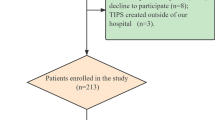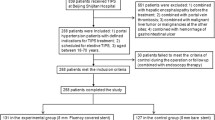Abstract
Purpose
Conflicting data exist regarding the appropriate shunt diameter for transjugular intrahepatic portosystemic shunt (TIPS) creation in cirrhotic patients. This study was designed to compare the clinical efficacy of TIPS using stent-grafts with 8- and 10-mm diameters.
Methods
In this retrospective study, cirrhotic patients who underwent TIPS technical successfully for the prevention of variceal rebleeding from December 2011 to June 2015 were included. Thirty-four patients with 8-mm TIPS and 380 patients with 10-mm TIPS were identified. Propensity score matching method produced 32 patients in each group for comparison.
Results
Baseline characteristics between two groups were comparable. There was no significant difference in variceal rebleeding rate between the two groups. The cumulative incidence of variceal rebleeding after 1 and 3 years was 6.4% and 35.5% in the 8-mm group, respectively, and 14.2% and 24.9% in the 10-mm group, respectively (P = 0.663). 8-mm TIPS conferred a significant decrease in hepatic encephalopathy (HE) rate compared with the 10-mm TIPS (16.1 vs. 32.6% at 1 year, 27.8 vs. 53.2% at 3 years, P = 0.034). The cumulative survival rates were similar between the two groups: 93.3% and 79.6% at 1 and 3 years, respectively, in the 8-mm TIPS group vs. 87.3% and 72.1% at 1 and 3 years, respectively, in the 10-mm TIPS group (P = 0.451).
Conclusion
The placement of 8-mm TIPS was sufficient to decompress the portal hypertension and prevent variceal rebleeding. The use of the 8-mm stent-graft can decrease HE rates compared with 10-mm stent-graft, although no survival benefit was observed.



Similar content being viewed by others
Abbreviations
- TIPS:
-
Transjugular intrahepatic portosystemic shunt
- PSG:
-
Portosystemic gradient
- HE:
-
Hepatic encephalopathy
- ePTFE:
-
Expanded polytetrafluoroethylene
- SD:
-
Standard deviation
- PSM:
-
Propensity score matching
- MELD:
-
Model for end-stage liver disease
- PVT:
-
Portal vein thrombosis
- PT:
-
Prothrombin time
- INR:
-
International normalized ratio
- TB:
-
Total bilirubin
- HCC:
-
Hepatocellular carcinoma
References
Parker R. Role of transjugular intrahepatic portosystemic shunt in the management of portal hypertension. Clin Liver Dis. 2014;18(2):319–34.
Rossle M. TIPS: 25 years later. J Hepatol. 2013;59(5):1081–93.
Boyer TD, Haskal ZJ. The role of transjugular intrahepatic portosystemic shunt (TIPS) in the management of portal hypertension: update 2009. Hepatology. 2010;51(1):306.
Haskal ZJ, Martin L, Cardella JF, et al. Quality improvement guidelines for transjugular intrahepatic portosystemic shunts. J Vasc Interv Radiol. 2003;14(9 Pt 2):S265–70.
Riggio O, Ridola L, Angeloni S, et al. Clinical efficacy of transjugular intrahepatic portosystemic shunt created with covered stents with different diameters: results of a randomized controlled trial. J Hepatol. 2010;53(2):267–72.
Luo X, Wang Z, Tsauo J, Zhou B, Zhang H, Li X. Advanced cirrhosis combined with portal vein thrombosis: a randomized trial of TIPS versus endoscopic band ligation plus propranolol for the prevention of recurrent esophageal variceal bleeding. Radiology. 2015;276(1):286–93.
de Franchis R. Revising consensus in portal hypertension: report of the Baveno V consensus workshop on methodology of diagnosis and therapy in portal hypertension. J Hepatol. 2010;53(4):762–8.
Conn HO, Leevy CM, Vlahcevic ZR, et al. Comparison of lactulose and neomycin in the treatment of chronic portal-systemic encephalopathy: a double blind controlled trial. Gastroenterology. 1977;72(4 Pt 1):573–83.
Siegerstetter V, Krause T, Rossle M, et al. Transjugular intrahepatic portosystemic shunt (TIPS) thrombogenicity in stents and its effect on shunt patency. Acta Radiol. 1997;38(4 Pt 1):558–64.
Krajina A, Hulek P, Fejfar T, Valek V. Quality improvement guidelines for transjugular intrahepatic portosystemic shunt (TIPS). Cardiovasc Interv Radiol. 2012;35(6):1295–300.
Sauerbruch T, Mengel M, Dollinger M, et al. Prevention of rebleeding from esophageal varices in patients with cirrhosis receiving small-diameter stents versus hemodynamically controlled medical therapy. Gastroenterology. 2015;149(3):660–8.
Holster IL, Tjwa ET, Moelker A, et al. Covered TIPS vs endoscopic therapy + beta-blocker for prevention of variceal rebleeding. Hepatology. 2015;63(2):581–9.
Sanyal AJ, Freedman AM, Shiffman ML, Purdum PP III, Luketic VA, Cheatham AK. Portosystemic encephalopathy after transjugular intrahepatic portosystemic shunt: results of a prospective controlled study. Hepatology. 1994;20(1 Pt 1):46–55.
Somberg KA, Riegler JL, LaBerge JM, et al. Hepatic encephalopathy after transjugular intrahepatic portosystemic shunts: incidence and risk factors. Am J Gastroenterol. 1995;90(4):549–55.
Bai M, Qi X, Yang Z, et al. Predictors of hepatic encephalopathy after transjugular intrahepatic portosystemic shunt in cirrhotic patients: a systematic review. J Gastroenterol Hepatol. 2011;26(6):943–51.
Riggio O, Angeloni S, Salvatori FM, et al. Incidence, natural history, and risk factors of hepatic encephalopathy after transjugular intrahepatic portosystemic shunt with polytetrafluoroethylene-covered stent grafts. Am J Gastroenterol. 2008;103(11):2738–46.
Rossle M, Gerbes AL. TIPS for the treatment of refractory ascites, hepatorenal syndrome and hepatic hydrothorax: a critical update. Gut. 2010;59(7):988–1000.
Gaba RC, Parvinian A, Minocha J, et al. Should transjugular intrahepatic portosystemic shunt stent grafts be underdilated? J Vasc Interv Radiol. 2015;26(3):382–7.
Author information
Authors and Affiliations
Corresponding author
Ethics declarations
Conflict of interest
On behalf of all authors, the corresponding author states that there is no conflict of interest.
Rights and permissions
About this article
Cite this article
Luo, X., Wang, X., Zhu, Y. et al. Clinical Efficacy of Transjugular Intrahepatic Portosystemic Shunt Created with Expanded Polytetrafluoroethylene-Covered Stent-Grafts: 8-mm Versus 10-mm. Cardiovasc Intervent Radiol 42, 737–743 (2019). https://doi.org/10.1007/s00270-019-02162-4
Received:
Accepted:
Published:
Issue Date:
DOI: https://doi.org/10.1007/s00270-019-02162-4




